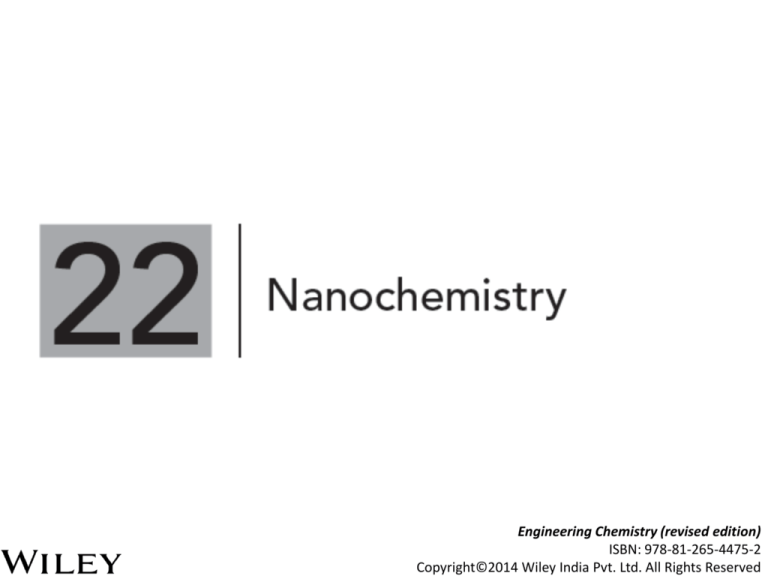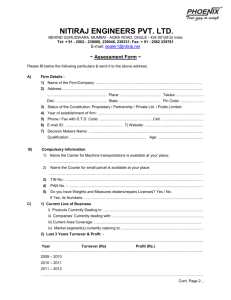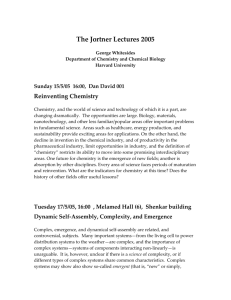
Engineering Chemistry (revised edition)
ISBN: 978-81-265-4475-2
Copyright©2014 Wiley India Pvt. Ltd. All Rights Reserved
Introduction
Nanotechnology can be defined as the manipulation of atoms and molecules at
nano (one billionth) scale (1–100 nm) to produce devices, structures or systems
having at least one novel or superior property. The materials having at least one
dimension in the nano scale are called nanomaterials.
Properties of Nanomaterials
1.
The surface area to volume ratio of the nanomaterials is relatively larger than
that of bulk materials of the same mass. This increases the chemical
reactivity and affects strength and electrical properties of the material.
2.
The quantum confinement is observed at nanometer sizes that changes the
optical, electronic and magnetic properties of the material. The band gap
increases as the size of the material is reduced to nanometer range. This
effect is caused by the phenomenon resulting from electrons and electron
holes being constricted into a dimension which approaches the critical
quantum measurement, known as the exciton Bohr radius.
Engineering Chemistry (revised edition)
ISBN: 978-81-265-4475-2
Copyright©2014 Wiley India Pvt. Ltd. All Rights Reserved
The combination of number of possible materials coupled with the concepts of
nanochemistry is mind boggling. A few of them are:
1.
Nanoparticles of various sizes and shapes such as, gold, silver nanoparticles.
2.
Nanooxides such as iron oxide, cadmium oxide
3.
Carbon nanotubes and fullerenes
4.
Nanopolymers and nanomembranes
5.
Nanocatalysts
6.
Nanoformulations for cosmetics, example, in sunscreens, anti-aging creams,
etc.
7.
Nanoceramics
Engineering Chemistry (revised edition)
ISBN: 978-81-265-4475-2
Copyright©2014 Wiley India Pvt. Ltd. All Rights Reserved
These materials have, in turn, applications in various domains:
1.
2.
3.
4.
5.
6.
7.
8.
9.
10.
11.
12.
13.
14.
In semiconductor devices, such as nanocapacitors
As therapeutic molecules (nanomedicine) for diseases such as cancer.
In targeted drug delivery
In agriculture
In electronics
As taste enhancers (nanofoods) and for packaging in food industry
In fuel cells
In chemical and biosensors
In fabric technology
In solar cells
Nanooptics
For manufacture of self-cleaning surfaces
In waste water treatment
Green nanotechnology
Engineering Chemistry (revised edition)
ISBN: 978-81-265-4475-2
Copyright©2014 Wiley India Pvt. Ltd. All Rights Reserved
Size-Dependent Properties
Particle-Size vs. Surface Area
If a macroscopic object is divided into smaller parts, the ratio of surface atoms
to interior atoms becomes a significant number of the total fraction of atoms.
Surface Chemistry of Materials
Due to increased surface area, nanomaterials possess greater surface energy and
are thermodynamically less stable. The atoms or molecules that exist on the
surface or the interface are somewhat different from atoms/molecules in the
bulk/interior of the material.
Engineering Chemistry (revised edition)
ISBN: 978-81-265-4475-2
Copyright©2014 Wiley India Pvt. Ltd. All Rights Reserved
Electronic Properties
Various physical properties such as thermal, optical and magnetic properties are
dependent on the electronic state of the material. Some characteristics of
electronic structure of solids are:
1.
In an isolated solid, the electrons move in quantified energy levels. When the
distance between atoms is less, electron orbitals interact with each other,
which leads to broadening of energy levels to form energy bands.
2.
The inner-shell electrons form narrow bands called internal bands and
electrons in external shell form valence bands. The electrons in excited state
form conduction band.
3.
The difference of energy between valence band and conduction band is
called energy gap. In metals (or conductors) this energy gap is zero; it is
small in case of semiconductors and large in case of insulators.
4.
The maximum energy for electrons at absolute zero (0 K) is called Fermi
level or Fermi energy. The physical properties of materials are mainly
governed by electrons that have energy larger than Fermi energy.
Engineering Chemistry (revised edition)
ISBN: 978-81-265-4475-2
Copyright©2014 Wiley India Pvt. Ltd. All Rights Reserved
Mechanical Properties
Nanocrystalline materials have an average crystallite size in the range 1 to 100 nm
and are characterized by numerous grain boundaries due to the small size of the
grain. The mechanical properties of nanocrystalline materials are determined by
their small grain size and the grain boundary. These properties are enhanced by
reducing the grain size, as grains of nano-size have no defects inside, unlike
micro-grains of relatively larger size.
For example, nanocrystalline copper is found to be three times more resistant to
applied stress than normal copper crystals and deformed homogeneously. The
crystal-linity of the grain structure is maintained right up to the grain boundary.
The fraction of atoms out of the total volume present at the grain boundaries is
large for small size grains and decreases with increase in their size.
Engineering Chemistry (revised edition)
ISBN: 978-81-265-4475-2
Copyright©2014 Wiley India Pvt. Ltd. All Rights Reserved
General Methods of Synthesis
Schematic representation of the
building up of nanostructures.
Engineering Chemistry (revised edition)
ISBN: 978-81-265-4475-2
Copyright©2014 Wiley India Pvt. Ltd. All Rights Reserved
Wet chemical synthesis of
nanomaterials (sol–gel process)
Liquid solid
reactions(precipitation)
Gas condensation processing
(GPC)
Chemical vapor condensation
(CVC)
Bottom-Up
Approach
Laser ablation
Hydrothermal synthesis
Thermolysis
Solvothermal synthesis
Electrodeposition
Engineering Chemistry (revised edition)
ISBN: 978-81-265-4475-2
Copyright©2014 Wiley India Pvt. Ltd. All Rights Reserved
Top-Down Approach
High-energy ball milling is the milling process commonly used in ceramic
processing and powder metallurgy, and involves particle size reduction, solid-state
alloying, mixing or blending, and particle shape changes. The process is used only
for hard, brittle materials which fracture, deform and cold weld during the milling
operation. The technique has been extended to produce a variety of
nanocrystalline, amorphous and quasicrystalline materials.
Some disadvantages associated with the process are:
1.
All particles of the precursor may not break down tothe required particle
size.
2.
The nanocrystalline materials prepared by this process may be contaminated
by milling tools and atmosphere. This can be reduced by minimizing the
milling time, using pure and ductile metal powders which can coat the
milling tools and seal the container to prevent exposure to atmospheric
gases.
Engineering Chemistry (revised edition)
ISBN: 978-81-265-4475-2
Copyright©2014 Wiley India Pvt. Ltd. All Rights Reserved
Characterization of Nanomaterials
Characterization of nanoparticles is important to understand and control their
synthesis and applications. However, the main challenge faced currently in
characterization of these materials is the inability and lack of instruments to
observe, measure and manipulate the materials at the nanoscale.
Common techniques are electron microscopy (TEM, SEM), atomic force
microscopy (AFM), dynamic light scattering (DLS), X-ray photoelectron
spectroscopy (XPS), powder X-ray diffraction (XRD), Fourier transform infrared
spectroscopy (FTIR), matrix-assisted laser desorption/ionization time-of-flight
mass spectrometry (MALDI-TOF), ultraviolet–visible spectroscopy, dual
polarization interferometry and nuclear magnetic resonance (NMR).
Engineering Chemistry (revised edition)
ISBN: 978-81-265-4475-2
Copyright©2014 Wiley India Pvt. Ltd. All Rights Reserved
Materials Self-Assembly
Engineering Chemistry (revised edition)
ISBN: 978-81-265-4475-2
Copyright©2014 Wiley India Pvt. Ltd. All Rights Reserved
Order
Building units
Interactions
Thermodynamic
stability
Characteristics of SelfAssembly
Environment
Spontaneity and
reversibility
Mass transport
Engineering Chemistry (revised edition)
ISBN: 978-81-265-4475-2
Copyright©2014 Wiley India Pvt. Ltd. All Rights Reserved
Classification of Self-Assembly
Equilibrium State of the
System
Size or Nature of Building
Units
System
Engineering Chemistry (revised edition)
ISBN: 978-81-265-4475-2
Copyright©2014 Wiley India Pvt. Ltd. All Rights Reserved
Classification of self-assembly based on size or nature of the building
units
Engineering Chemistry (revised edition)
ISBN: 978-81-265-4475-2
Copyright©2014 Wiley India Pvt. Ltd. All Rights Reserved
Formation of Self-Assembly
Self-Assembled Monolayers (SAMs)
Engineering Chemistry (revised edition)
ISBN: 978-81-265-4475-2
Copyright©2014 Wiley India Pvt. Ltd. All Rights Reserved
Electrostatic
Self-Assembly
(ESA) or Layer-by-Layer (LbL)
Self-Assembly
Engineering Chemistry (revised edition)
ISBN: 978-81-265-4475-2
Copyright©2014 Wiley India Pvt. Ltd. All Rights Reserved
There are several advantages in this method over other thin film deposition
techniques:
1.
The thin films formed by this technique are highly stable.
2.
LbL method offers high level of control over the thickness of the film
because of the linear growth of the layers.
3.
This method is simple, inexpensive and can be automated
Engineering Chemistry (revised edition)
ISBN: 978-81-265-4475-2
Copyright©2014 Wiley India Pvt. Ltd. All Rights Reserved
Mechanism of Self-Assembly
In terms of forces acting in the process, self-assembly occurs when a balance is
established between three different classes of forces, namely, attractive (driving)
forces, repulsive (opposition) forces and directional forces. Formation of micelles
or micellization from surfactant molecules is a classic example of self assembly
Micelles are surfactant aggregates formed when surfactant molecules are
dispersed in aqueous solution at a particular concentration known as the critical
micelle concentration (CMC).
Directed Self-Assembly
Directed self-assembly is quite distinct from spontaneous self-assembly. Physical,
chemical and geometrical cues can be added to a self-assembly process so that a
desired structure may be obtained. Directing a self-assembly may involve
lithographically patterning a substrate on which self-assembly occurs, so that selfassembly occurs only on specific regions. Honeycomb structured patterns, grid
structures, trenches and so on, have been formed by self-assembly directed by
lithographic patterning.
Engineering Chemistry (revised edition)
ISBN: 978-81-265-4475-2
Copyright©2014 Wiley India Pvt. Ltd. All Rights Reserved
Molecular Self-Assembly
Spontaneous assembly of molecules, without any external intervention is said to
be molecular selfassembly. Formation of molecular crystals, phase separated
polymers, colloids, lipid bilayers, protein folding, nucleic acid folding, selfassembled monolayers (SAMs) all are examples of molecular selfassembly.
There are two types of molecular self-assembly:
1.
Intermolecular self-assembly
2.
Intramolecular self-assembly.
Engineering Chemistry (revised edition)
ISBN: 978-81-265-4475-2
Copyright©2014 Wiley India Pvt. Ltd. All Rights Reserved
Molecular vs. Materials Self-Assembly
The principles and characteristics of molecular self-assembly are the same as selfassembly of materials. Molecular self-assembly also proceeds from a less ordered
state to a highly ordered structure. But there is a difference in the forces directing
the process. The self-assembly of materials is directed by a wide range of forces
based on the nature of the building units, such as non-covalent weak interactions,
elastic, colloidal, capillary, gravitational forces, etc. On the other hand, molecular
self-assembly is restricted to the weak non-covalent interactions such as hydrogen
bonding, metal coordination, van der Waals forces and π - π interactions. The
structure formed by molecular self-assembly is determined by the molecular
structures. A variety of structures of different sizes and shapes can be
synthesized by molecular self-assembly. It is feasible to construct challenging
molecular topologies using molecular self-assembly. For example, molecular
analog of Borromean rings has been constructed using DNA.
Engineering Chemistry (revised edition)
ISBN: 978-81-265-4475-2
Copyright©2014 Wiley India Pvt. Ltd. All Rights Reserved
Two-Dimensional Assemblies
1.
Interfaces (region where there is a gradual change of physicochemical
properties from one phase to the adjacent phase) can undergo direct selfassembly along certain directions by providing physical, geometrical and
chemical spaces.
2.
This type of self-assembly is known as interfacial or surface self-assembly.
Since there is a restriction of at least one of the dimensions of self-assembly
in the length scales of the components, it is also known as two-dimensional
self-assembly.
3.
The average size of this assembly is 10 nm. It differs from one-dimensional
assemblies as one dimensional assemblies form arrays while two-dimensional
assemblies form lattice.
4.
It is different from three-dimensional or bulk self-assembly because the
interactions that take place between the interface are inevitable. The strength
of such interactions may vary, but is usually comparable to colloidal and
intermolecular forces between the building units.
Engineering Chemistry (revised edition)
ISBN: 978-81-265-4475-2
Copyright©2014 Wiley India Pvt. Ltd. All Rights Reserved
This intrinsic factor furnishes three typical, unique characteristics to twodimensional self-assembly that differentiate it from three-dimensional selfassembly:
1.
For bulk self-assembly, it is a prerequisite that the building units are
amphiphilic, so that proper balance of forces is ensured. But in the case of
interfacial self-assembly, the building units may or may not be amphiphilic.
2.
The intermolecular and colloidal forces among the building units are altered
by their interaction with the interface. For example, on adsorption onto
interfaces, even non-polar molecules can acquire dipole moments. This
characteristic provides additional means of control over the self-assembly
processes at interfaces.
3.
The self-assembled aggregates formed in interfacial self-assembly are found
to have significantly different chemical and physical properties than those in
bulk self-assembly. This is because the self-assembled aggregates in
interfacial self-assembly prevail in a state of confinement on the interfaces.
Engineering Chemistry (revised edition)
ISBN: 978-81-265-4475-2
Copyright©2014 Wiley India Pvt. Ltd. All Rights Reserved
Interfaces are formed spontaneously between any two phases. Interfaces have
zero thickness geometrically and macroscopically and therefore are twodimensional. However, microscopically and physicochemically, interfaces are
three-dimensional, having a thickness in the range of approximately 1 nm-1 μm
(Figure).
Engineering Chemistry (revised edition)
ISBN: 978-81-265-4475-2
Copyright©2014 Wiley India Pvt. Ltd. All Rights Reserved
Forces Involved in Interfacial Self-Assembly
The interfaces, having thickness in the nanometer range, act as nanometer scale
surface wells when the building units are adsorbed onto them. This is because the
interplay of intermolecular forces of the building units is confined to the
interfaces. As the physicochemical properties change gradually within the
interface, the interaction between the building units becomes more favorable
along the interface direction and less favorable through either phase direction
(either phase 1 or 2).
The intermolecular and colloidal forces between the building units can act as
either attractive or repulsive forces for the process of interfacial self-assembly.
But the direction of the interfacial self-assembly is determined by the interaction
between the building units and interfaces and is thus referred to as ‘intrinsic
directional force’.
Engineering Chemistry (revised edition)
ISBN: 978-81-265-4475-2
Copyright©2014 Wiley India Pvt. Ltd. All Rights Reserved
General Strategy of Two-Dimensional Self-Assembly
The general strategy of a two-dimensional self-assembly can be explained as
follows:
1.
The self-assembly process is initiated when the building units are first
located at the interface. This is a prerequisite condition, regardless of the
type of the interface. This is usually achieved by adsorption, mainly
physisorption.
2.
When the force balance between the building units is fulfilled, the building
units at the interface self-assemble form self-assembled aggregates.
3.
The force balance determines the mode of packing of the building units, the
specific structure of the self-assembled aggregates and the prospect of
subsequent higher order self-assembly.
Engineering Chemistry (revised edition)
ISBN: 978-81-265-4475-2
Copyright©2014 Wiley India Pvt. Ltd. All Rights Reserved
Examples of Two-Dimensional Self-Assembly
1.
Self-Assembly at the Gas-Liquid Interface
2.
Self-Assembly at the Liquid-Solid Interface
3.
Self-Assembly at the Liquid-Liquid Interface
4.
Self-Assembly at the Gas-Solid Interface
Engineering Chemistry (revised edition)
ISBN: 978-81-265-4475-2
Copyright©2014 Wiley India Pvt. Ltd. All Rights Reserved
Formation of Langmuir monolayer
Engineering Chemistry (revised edition)
ISBN: 978-81-265-4475-2
Copyright©2014 Wiley India Pvt. Ltd. All Rights Reserved
Mesoscale Self-Assembly (MESA)
1.
Mesoscale self-assembly (MESA) is the self-assembly of objects ranging
in size from 10 nm to 10 mm through non-covalent forces such as capillary,
magnetic, electrostatic and light forces. This involves the extension of ideas
emerging from molecular self-assembly to larger objects.
2.
Regular arrays of topologically complex, mesoscale objects can be prepared
by self-assembly in fluids, with the structure of the arrays determined by
shapes of the assembling objects, the wettability of their surfaces and the
lateral capillary forces at the interfaces.
3.
Self-assembly results from minimization of the interfacial free energy of the
liquid-liquid interface. The capillary interactions between objects can be
viewed as a type of ‘bond’ that is analogous to chemical bonds that act
between atoms and molecules.
4.
Assembly by capillary forces relies upon particle-particle interaction and
interaction between particles and their environment.
Engineering Chemistry (revised edition)
ISBN: 978-81-265-4475-2
Copyright©2014 Wiley India Pvt. Ltd. All Rights Reserved
Coercing Colloids
Coercing colloids are 3D photonic crystals of colloidal particles with periodic
dielectric lattices an optical analog of electronic semiconductor (periodicity of
potential in semiconductor crystal affecting the motion of electrons). The size
of these colloidal particles is 1-100 nm. These colloidal crystals and films are
prepared by electrophoresis, sedimentation, evaporation induced self-assembly,
application of electric or magnetic field.
Applications of Coercing Colloids
They find applications in signal processing, switching and sensing of light, optical
computing and telecommunications. Three-dimensional colloidal photonic crystal
can be utilized as optical pulse control devices for ultra-short laser pulses (femto
second) and high power laser application. Bioinspired colloidal photonic crystals
also find application in catalysis, chromatographic separations and color-based
sensors for monitoring changes in environment.
Engineering Chemistry (revised edition)
ISBN: 978-81-265-4475-2
Copyright©2014 Wiley India Pvt. Ltd. All Rights Reserved
Supramolecular Structures
1.
Host-guest complexation
Engineering Chemistry (revised edition)
ISBN: 978-81-265-4475-2
Copyright©2014 Wiley India Pvt. Ltd. All Rights Reserved
2.
Self-assembly between complementary molecules
3.
Crystal lattice self-assembly: By specific selection of the functional
molecular building blocks, the weak and non-covalent bonds lead to the
formation of crystal packing In this case, no difference in size is observed
and no species acts as a host to the other. Self-assembly and selforganization leads to the formation of organized, discrete aggregates of
various intriguing structures like boxes, squares, helicates, catenanes,
capsules, grids and many others.
Engineering Chemistry (revised edition)
ISBN: 978-81-265-4475-2
Copyright©2014 Wiley India Pvt. Ltd. All Rights Reserved
Applications of Supramolecular Structures
1.
Self-organized supramolecular organic nanostructures have potential
applications in molecular electronics, photonics and as precursors for
nanoporous catalysts.
2.
Supramolecular metal-ligand assembly finds application as host for catalytic
reactions in organic chemistry.
3.
Supramolecular crystal lattice self-assembly opens up new avenues for novel
nanostructured materials with unique functional properties and for
miniaturization and nanofabrication technologies.
4.
Supramolecular architectures are used to obtain efficient near infrared
photoluminescence and electroluminescence using a three-dimensional p
conjugation.
5.
SAMs are highly ordered supramolecular arrays of molecules chemisorbed
on metal substrates.
6.
They allow reactions to take place in the solid state. This leads to reduction
in use of solvents and they can also be used in green chemistry..
Engineering Chemistry (revised edition)
ISBN: 978-81-265-4475-2
Copyright©2014 Wiley India Pvt. Ltd. All Rights Reserved
Nanoscale Materials
Nanocrystals and Clusters
Applications of Nanocrystals and Clusters
1.
Many techniques are developed to produce clusters for use in different
applications like thin film manufacture for advanced electronic or optical
devices, production of nanoporous structures, and fabrication of thin
membranes of nanoporous materials.
2.
Nanoclusters of technologically important inorganic bulk materials such as
SiO2, ZnO, CdS, etc., were found to be photoinitiators while their
corresponding bulk materials did not exhibit this property. ZnS clusters and
its aggregates act as effective photocatalysts in reduction of organic
compounds.
3.
The nanoclusters of cerium oxide (CeO2-x) materials have been found to
possess a significant concentration of Ce3+ and oxygen vacancies resulting in
excellent poisoning resistance against H2O and CO2 and substantial
reduction in the temperature of selective SO2 reduction by CO.
Engineering Chemistry (revised edition)
ISBN: 978-81-265-4475-2
Copyright©2014 Wiley India Pvt. Ltd. All Rights Reserved
Nanocrystalline Materials
Applications of Nanocrystalline Materials
1.
Crystalline nanoparticles used in a solar panel is claimed to have more
efficiency and is more flexible and cheaper than many other panels.
2.
Crystalline nanoparticles of zeolite are reportedly used as filter to convert
crude oil to diesel fuel by a method cheaper than the conventional way.
3.
Nanocrystalline and nanoporous Si exhibit electroluminescence,
photoluminescence and refractive index changes that can be controlled.
4.
The size control of nanoscale catalyst particles has been achieved in
preparation of highly dispersed metal colloids and metal clusters fixed on to
substrates by electrochemical reduction of metal salts.
5.
Materials with higher hydrogen storage per unit volume and weight and
considerably increased rate of hydrogen adsorption, like mixtures of
nanoscale particles of Mg and Mg2Ni with high surface area, have been
produced by mechanical means.
Engineering Chemistry (revised edition)
ISBN: 978-81-265-4475-2
Copyright©2014 Wiley India Pvt. Ltd. All Rights Reserved
Fullerenes
Two forms of fullerenes: (a) Bucky ball form; (b) nanotube form.
Engineering Chemistry (revised edition)
ISBN: 978-81-265-4475-2
Copyright©2014 Wiley India Pvt. Ltd. All Rights Reserved
Buckyball clusters
Nanotubes
Megatubes
Polyfullerenes
Types of Fullerenes
Endohedral fullerenes
Exohedral fullerenes and
heterofullerenes
Nano-onions
Fullerene rings
Engineering Chemistry (revised edition)
ISBN: 978-81-265-4475-2
Copyright©2014 Wiley India Pvt. Ltd. All Rights Reserved
Polyfullerenes
Nano-onions
Engineering Chemistry (revised edition)
ISBN: 978-81-265-4475-2
Copyright©2014 Wiley India Pvt. Ltd. All Rights Reserved
Endohedral fullerenes
Engineering Chemistry (revised edition)
ISBN: 978-81-265-4475-2
Copyright©2014 Wiley India Pvt. Ltd. All Rights Reserved
Characteristics of Fullerenes
1.
An important characteristic of C60 molecule is its high symmetry with 120
symmetrical operations which map the molecule onto itself. Each carbon
atom bonds with three other adjacent atoms using sp2 hybridization.
2.
Chemically fullerenes are stable; breaking the balls requires temperatures
over 1000°C. However, fullerenes are not unreactive as they possess Π electrons which are free to localise or delocalise in different chemical
situations, reactions such as addition reactions and redox reactions, are
possible on their surface. This leads to covalent exohedral adducts and salts.
3.
Fullerenes are insoluble in water, sparingly soluble in many other solvents
and more soluble in toluene and carbon disulphide.
4.
Fullerenes themselves are non-toxic but some of the derivatives of
fullerenes could be harmful to the health.
Engineering Chemistry (revised edition)
ISBN: 978-81-265-4475-2
Copyright©2014 Wiley India Pvt. Ltd. All Rights Reserved
Applications of Fullerenes
1.
Oxidation involving free radicals causes cell damage, food spoilage, plastics
deterioration, metal corrosion, etc. Therefore, fullerenes due to powerful
antioxidant property (they reportedly react readily at a high rate with free
radicals), can find application in health and personal care areas.
2.
Fullerene nanotubes, which have small diameter and high aspect ratio, find use
as ideal materials to be used as tips in scanning probe microscopy (SPM),
such as scanning tunneling microscopy and atomic force microscopy. The
nanotubes attached to the tip enhance SPM resolution to nanoscale as
compared to the conventional silicon tip.
3.
Fullerene nanotubes are promising as chemical molecular sensors, due to
their small size, room temperature operation and high sensitivity. They find
application as coating materials on some chemical sensors, such as quartz
crystal microbalance and surface acoustic wave sensors (SAW).
Engineering Chemistry (revised edition)
ISBN: 978-81-265-4475-2
Copyright©2014 Wiley India Pvt. Ltd. All Rights Reserved
4.
Field emission displays (FEDs) using carbon nanotubes are being explored
by scientists which are expected to be better in terms of power, cost and
view angles than the currently available flat panel displays, such as liquid
crystal display (LCD) and plasma.
5.
Fullerenes blended with polymers are used in organic photovoltaics.
6.
Fullerenes can react readily with free radicals, thus preventing cell damage
due to oxidation. They can hence be used as antioxidants.
7.
Pharmaceutical companies are exploring the use of fullerenes in controlling
Alzeimer’s and HIV.
8.
Fullerenes and its modified forms are capable of targeted and controlled
delivery of drugs and genes into cells.
9.
Endofullerenes with their protected cage-structure are capable of being
applied in MRI, X-ray imaging and radiopharmaceutical diagnostic
applications.
10. Other applications of fullerenes like catalysts in certain organic reactions,
water purification, fuel cell membrane material are also being explored.
Engineering Chemistry (revised edition)
ISBN: 978-81-265-4475-2
Copyright©2014 Wiley India Pvt. Ltd. All Rights Reserved
Carbon Nanotubes
Types of Carbon
Nanotubes
Single-walled
nanotubes
(SWNTs)
Multiwalled
nanotubes
(MWNTs)
Engineering Chemistry (revised edition)
ISBN: 978-81-265-4475-2
Copyright©2014 Wiley India Pvt. Ltd. All Rights Reserved
Strength
Hardness
Characteristics of
Carbon
Nanotubes
Kinetic
Thermal
Engineering Chemistry (revised edition)
ISBN: 978-81-265-4475-2
Copyright©2014 Wiley India Pvt. Ltd. All Rights Reserved
Applications of Carbon Nanotubes
1.
Carbon nanotubes find application in nanoelctronics. The nanotube
integrated memory circuit was first made in 2004. CNT-based transistors can
operate at room temperature and are capable of digital switching using a
single electron.
2.
A paper battery is made up of a paper-thin sheet of cellulose infused with
aligned carbon nanotubes. The nanotubes act as electrodes to conduct
electricity. These batteries provide a long and steady power output
comparable to a conventional battery (lithium battery), as well as quick
release of high energy (as a supercapacitor).
3.
The solar cells have been developed at the New Jersey Institute of
Technology using a carbon nanotube complex, formed by a mixture of
carbon nanotubes and carbon buckyballs (fullerenes) to form snake-like
structures.
4.
Carbon nanotubes may be used to improve the efficiency of ultracapacitors.
The activated charcoal used in conventional ultracapacitors has many small
hollow spaces of various sizes, which create a large surface to store electric
charge.
Engineering Chemistry (revised edition)
ISBN: 978-81-265-4475-2
Copyright©2014 Wiley India Pvt. Ltd. All Rights Reserved
Other applications of carbon nanotubes include:
1.
They have been introduced in nano-electromechanical systems, including
mechanical memory elements and nanoscale electric motors.
2.
CNTs find applications in composite polymer materials where they are used
to further add to the strength of the polymers.
3.
As CNTs have high mechanical strength, they are being explored for
fabricating clothes’ stab-proof and bullet-proof properties.
4.
A flywheel fabricated using CNTs, when spun at a very high velocity on a
floating magnetic axis in vacuum, can store energy at a density approaching
that of fossil fuels.
5.
Due to their similarity in physical dimensions to those of biologically active
macromolecules such as proteins and DNA, carbon nanotubes find
increasing utility in biologically inspired design. Ultra-short SWNTs have
been used as in vivo nanoscale capsules. In cancer research, SWNTs inserted
around cancerous cells and excited with radio waves results in killing the
cancerous cells.
Engineering Chemistry (revised edition)
ISBN: 978-81-265-4475-2
Copyright©2014 Wiley India Pvt. Ltd. All Rights Reserved
Nanowires
A nanowire is a wire with diameter of the order of a nanometer (10−9 meters)
and an unconstrained longitudinal size. At these magnitudes since quantum
mechanical effects are important, nanowires are also known as quantum wires.
Applications of Nanowires
1.
They find a lot of applications in the fields of electronics, optics, magnetic
medium, sensor devices, etc.
2.
They are used in the magnetic information storage medium
3.
They find potential use in electronic applications such as junctions with
good rectifying characteristics. Junction diodes, memory cells and switches,
transistors, LEDs and inverter etc., have already been fabricated using
nanowire junctions.
4.
In biomedical field, nanowires are used to coat titanium implants which
reduce the risk of implant failure.
Engineering Chemistry (revised edition)
ISBN: 978-81-265-4475-2
Copyright©2014 Wiley India Pvt. Ltd. All Rights Reserved
Nanorods
Nanorods are nanoscale objects with each of their dimension in the range 1 to
100 nm. These are produced directly by chemical synthesis using metals or
semiconducting materials as starting material. Important examples are ZnO and
gold nanorods.
ZnO nanorods are generally prepared by vapor phase method. The vapors of
ZnO may be obtained by any of the following three methods:
1.
Chemical reduction: First ZnO is reduced to zinc metal vapors, transferred
to growth zone and then reoxidized to ZnO vapors.
2.
Thermal evaporation: Powdered ZnO (commercial grade) is mixed with
SnO2 and heated to high temperature.
3.
Vapor–liquid–solid method: Droplets of catalysts such as gold, copper, tin
are deposited on a substrate and the gaseous mixture comprising Zn vapor
and CO/CO2, reacts at the catalyst-substrate interface, followed by
nucleation and growth. This method is most commonly used.
Engineering Chemistry (revised edition)
ISBN: 978-81-265-4475-2
Copyright©2014 Wiley India Pvt. Ltd. All Rights Reserved
Applications of Nanorods
1.
The main application of nanorods is in the area of display technologies
because their reflectivity changes on change of orientation with an applied
electrical field. They are also used in microelectromechanical (MEMS)
systems.
2.
These are conjugated with cancer therapeutic agents and ingested. Because
they absorb near IR and generate heat when excited with IR radiation,
nanorods selectively absorbed by the cancerous cells are heated on exposure
to IR radiation and destroyed.
3.
Nanorods fabricated using semiconducting materials are used in energy
harvesting systems and light emitting diodes. ZnO nanorods are also
extensively used to fabricate nanoscale electronic devices.
Engineering Chemistry (revised edition)
ISBN: 978-81-265-4475-2
Copyright©2014 Wiley India Pvt. Ltd. All Rights Reserved
Dendrimers
Engineering Chemistry (revised edition)
ISBN: 978-81-265-4475-2
Copyright©2014 Wiley India Pvt. Ltd. All Rights Reserved
Applications of Dendrimers
1.
Dendrimers are used in several biomedical applications. They are used in in
vitro diagnosis of cardiac problems. They are used as contrast agents in
preclinical studies for magnetic resonance (MRI).
2.
In industrial processes, the combination of high surface area and high
solubility makes dendrimers promising nanoscale catalysts. They have
nanoscopic cavities which act like microenvironment for molecular reactions
and reactor sites for catalysis.
3.
Dendrimers with tailored solubility properties can find use in environment
friendly industrial processes.
4.
Amphiphilic dendrimer are useful in forming interfacial liquid membranes
for stabilizing aqueous-organic emulsion. This helps in extracting chemical
compounds between two phases. This arrangement holds promise for the
development of organic chemistry in aqueous medium.
5.
Dendrimers also find use in pH or proton sensors.
Engineering Chemistry (revised edition)
ISBN: 978-81-265-4475-2
Copyright©2014 Wiley India Pvt. Ltd. All Rights Reserved
Nanocomposites
A nanocomposite is a matrix reinforced by added nanoparticles.
Nanocomposite is a multiphase solid material with one of the phases having
dimensions <100 nm. The reinforcing material can be particles, sheets or fibres
(e.g., carbon nanotubes). Due to the exceptionally high surface area to volume
ratio of the reinforcing phase and/or its high aspect ratio, the area of the
interface between the matrix and reinforcement phase(s) in nanocomposites is
typically an order of magnitude greater than for conventional composite
materials.
Nanocomposites can be of following types:
1.
Ceramic-matrix nanocomposites
2.
Metal-matrix nanocomposites
3.
Polymer-matrix nanocomposites
Engineering Chemistry (revised edition)
ISBN: 978-81-265-4475-2
Copyright©2014 Wiley India Pvt. Ltd. All Rights Reserved
Applications of Nanocomposites
1.
In material science:
• In production of batteries with greater power output. For example,
silicon-carbon nanoparticles form anodes for lithium ion batteries.
• In production of structural parts that have a high strength-to-weight
ratio.
• In making lightweight sensors with nanocomposites.
• In making flexible batteries.
• Due to improved mechanical properties, nanocomposites are used in
automotive and industries involved in making door handles, engine
covers, impellers and blades for vacuum cleaners, power tool housings
and covers for portable electronic equipment such as mobile phones,
etc.
• Nanoclay incorporated materials act as barriers to gases.
• Significant reductions in flammability and transmission of solvents
through polymers incorporated with nanoclay fillers can result in the use
of these materials as both fuel tank and fuel line components for cars.
Engineering Chemistry (revised edition)
ISBN: 978-81-265-4475-2
Copyright©2014 Wiley India Pvt. Ltd. All Rights Reserved
2.
3.
In life science
•
In replacement of tissues or tissue engineering (of skin, bone, cartilage,
blood vessels) damaged by sickness or accidents.
•
In drug delivery.
•
In biosensor applications since core shell fibers of nanoparticles with
fluid cores and solid shells can be used to entrap proteins, bacteria or
viruses.
The other future applications, owing to the possibility of building ordered
arrays of nanoparticles in the polymer matrix, are in the manufacture of
nanocomposite circuit boards, in neural networks applications,
optoelectronics and optical computing and magneto-optical storage media
manufacturing.
Engineering Chemistry (revised edition)
ISBN: 978-81-265-4475-2
Copyright©2014 Wiley India Pvt. Ltd. All Rights Reserved
Biological Nanomaterials
1.
Biological nanomaterials are biological systems which are inherently nano in
size. They serve as models and help in understanding the behavior of
nanomaterials in general and lead us to approaches like biomimicking. There
are many nanophase materials in biological systems.
2.
For example, living systems produce mineral material of the bone with
particle size in the nanometer scale. These biological nanomaterials could
even be used as direct source of novel materials or modified through in vivo
procedures and in in vitro manipulations.
3.
Some examples of biological nanomaterials are ferritins and related ironstorage proteins (for probing the magnetic properties of nanoscale materials
and also to investigate iron metabolism in living organisms), nanoparticles
found in magnetotactic bacteria (use earth’s magnetic lines to orient
themselves and move in the direction of nutritional or chemical gradients),
etc.
Engineering Chemistry (revised edition)
ISBN: 978-81-265-4475-2
Copyright©2014 Wiley India Pvt. Ltd. All Rights Reserved
General Applications of Nanomaterials
The impact of nanotechnology and use of nano-materials extends from
healthcare, medicine, energy, agriculture, food to fields such as electronics,
communication, optics, chemistry and computing.
In Medicine
The size of nanomaterials is very similar to that of biological molecules and
structures; therefore, these find extensive use in both in vivo and in vitro
biomedical applications. The integration of nanomaterials with biology has led to
development of various diagnostic devices, contrast agents, analytical tools,
physical therapy applications and drug delivery vehicles.
1.
Diagnostics:
2.
Drug delivery
3.
Tissue repair
4.
Transdermal drug delivery
Engineering Chemistry (revised edition)
ISBN: 978-81-265-4475-2
Copyright©2014 Wiley India Pvt. Ltd. All Rights Reserved
In Electronics and Communication
Nanotechnology has brought revolution in telecommunication, computing and
networking industries. The principle aim of nanotechnology is to produce three
dimensional confined quantum structured electronic devices such as quantum
wires and quantum dot devices. Some successful devices are:
1.
Quantum well lasers for telecommunication.
2.
High electron mobility transistors (HEMT) with low noise.
3.
High gain microwave application and vertical cavity surface emitting lasers
for data communication and sensor coding.
Engineering Chemistry (revised edition)
ISBN: 978-81-265-4475-2
Copyright©2014 Wiley India Pvt. Ltd. All Rights Reserved
Some consumer products using nanomaterials are:
1.
Computer hardware
2.
Display devices.
3.
Mobile and communication products.
4.
Audio products.
5.
Cameras and films, etc.
Nanomaterials are used to develop semiconductors with much advanced
properties. These include:
1.
Transistors from carbon nanotubes with nanometer dimensions.
2.
Memory chips with density of one tetrabyte per square inch.
3.
Very high speed transistors from single atom thick graphene film.
4.
Lightweight nanoemissive display panel using carbon nanotubes.
5.
Nomfet (nanoparticle organic memory field-effect transistor) obtained by
combining gold nanoparticles with organic molecules.
Engineering Chemistry (revised edition)
ISBN: 978-81-265-4475-2
Copyright©2014 Wiley India Pvt. Ltd. All Rights Reserved
In Energy Science
Nanomaterials, particularly nanocomposites, are increasingly being used to
replace conventional materials for conversion of energy. Some examples of their
use are:
1.
Non-porous crystalline solids called zeolites are used for refining of oil.
2.
Quantum dots can be used as sources of light emissions.
3.
Electrode materials can be changed by nano-structuring, that is, can be
imparted nano-texture to improve electrical performance of batteries.
4.
Energy production can be brought about using nanomaterials as clean and
high efficiency energy sources.
5.
Solar cells can be integrated from nanoscale crystals of semiconductors
coated with light-absorbing dye-emitting electrons and from nanostructured
diamond thermal cells that capture heat and light from the lattice and emit
high-energy electrons.
6.
Ultraporous nanomaterials are being explored for storing hydrogen at highdensities for fuel-cell powered cars.
Engineering Chemistry (revised edition)
ISBN: 978-81-265-4475-2
Copyright©2014 Wiley India Pvt. Ltd. All Rights Reserved
In Catalysis
Heterogeneous catalysts used in industry today, consist of small particles (1-10
nm) of catalytically active material attached to porous support. Nanoparticles of
metals, semiconductors, oxides, and other compounds are widely used for
important chemical reactions.
There are four main categories of nano-catalysts based on the composition.
These include:
1.
Gold-based (e.g., Au/TiO2, Au/MgO)
2.
Other metal based (e.g., Cu, Rh,)
3.
Platinum or palladium based (e.g., Pt/Ru/Ni)
4.
Nanosize metal particles dispersed
Pt/polypyrrole)
in polymers (e.g., Cu/polyaniline,
Engineering Chemistry (revised edition)
ISBN: 978-81-265-4475-2
Copyright©2014 Wiley India Pvt. Ltd. All Rights Reserved
Miscellaneous Applications
1.
2.
3.
4.
5.
6.
7.
Nano zinc oxide and titanium oxide are used in sunscreen creams, lotions
and other cosmetics. These nanoparticles become transparent and retain
their ability to absorb UV radiation.
Nanoparticles of tungsten-carbide–cobalt provide a hard coating. This
results in a greater resistance to wear in applications such as drill bits, cutting
tools and jet engine parts.
Nano coating over glass produces self-cleaning glass, which becomes
transparent or opaque according to the current applied.
Nanotechnology finds applications in energy storage and its conversion.
Nanomaterials are investigated as electrode materials in batteries and fuel
cells. Nanotubes also offer enhanced hydrogen storage capability for the use
in fuel cells.
Nanotechnology finds applications in the production, processing, safety and
packaging of food stuffs.
Nanofibers in clothes make waterproof and stain-repellant or wrinkle-free
and can be washed less frequently.
Engineering Chemistry (revised edition)
ISBN: 978-81-265-4475-2
Copyright©2014 Wiley India Pvt. Ltd. All Rights Reserved
Future Perspectives of Nanochemistry
Witnessing an exponential progress, nanotechnology is today among the fastest
growing areas of science and technology. Nanotechnology can be expected to
accomplish the following in the near future.
1.
Create integrated circuits using three-dimensional carbon nanotubes
contributing to the growth of computer power.
2.
Design solar panels with greater efficiency using nanocrystalline materials.
3.
Fabricate lighter and stronger military equipment using nanomaterial
composites.
4.
Revolutionise display technologies allowing bright images, light weight, less
power consumption and wider viewing angles using nanostructured
polymers.
5.
Contribute to more efficient, energy saving chemical manufacturing
processes with reduced waste by-products using nanostructured catalysts.
Engineering Chemistry (revised edition)
ISBN: 978-81-265-4475-2
Copyright©2014 Wiley India Pvt. Ltd. All Rights Reserved
6.
Protect humanity from ill health with reformulated pharmaceutical products
using nanosized particle, improved targeted drug delivery, their
administration and absorption, create tissue compatible implants and even
build artificial organs.
7.
Protect the environment from degradation by designing nanomembranes to
capture carbon dioxide in the exhaust, using nanoparticles for effective
cleaning up of organic solvents, using nanoclusters of silver for reducing
polluting by products, using nanowires making alternate energy sources cost
effective.
8.
Make safe drinking water available to all at reasonable cost with water
purification bottles, using filters only a few nanometres in width.
9.
Produce smart materials with nanotechnology surfaces which are highly
resistant to bacteria, dirt and scratches and fabrics that are highly resistant to
liquid and stain-proof.
10. Nanotechnology is expected to continue the ever increasing miniaturization
of semiconductor processing and memory devices.
Engineering Chemistry (revised edition)
ISBN: 978-81-265-4475-2
Copyright©2014 Wiley India Pvt. Ltd. All Rights Reserved







